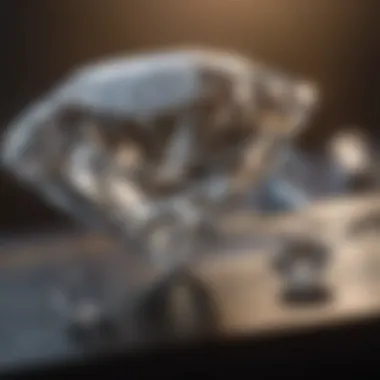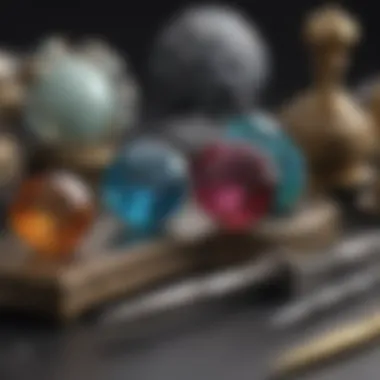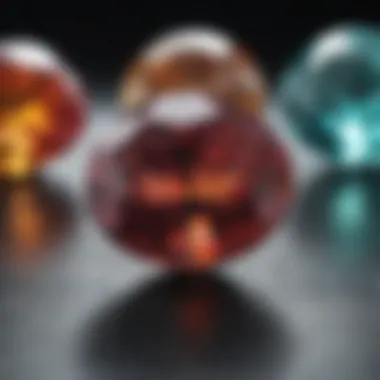Understanding Carats: The Weight Behind Gemstones


Intro
Carats play an essential role in understanding gemstones. They serve as a measure of weight, influencing the value and appeal of these exquisite stones. Knowing more about carats empowers both collectors and enthusiasts to make informed decisions when purchasing gemstones. This guide will take a closer look at the factors that define carats and their implications in the gemstone market.
Gemstone Overview
Definition and Characteristics
Gemstones are naturally occurring minerals that have aesthetic value. They are prized for their beauty, rarity, and durability. Some common gemstone characteristics include clarity, color, cut, and carat weight.
Carats are a unit of weight specifically used for gemstones and diamonds. One carat equals 200 milligrams. However, it is crucial to recognize that a gem's weight does not solely determine its value. Factors such as quality and origin also play a vital role.
Classification of Gemstones
Gemstones can be broadly classified into two categories: precious and semi-precious. Precious gemstones include diamonds, rubies, sapphires, and emeralds. These are usually more sought after and command higher prices due to their rarity and demand. Semi-precious stones encompass a wider range, including amethyst, garnet, and topaz, which are still beautiful but not as rare.
Understanding each gemstone's characteristics helps in the evaluation process, highlighting individual features that may affect pricing.
Historical Significance
Ancient Uses and Cultural Importance
Historically, gemstones have found applications ranging from adornment to spiritual significance. Ancient civilizations often associated gemstones with certain qualities or powers. For instance, Egyptians used lapis lazuli in burial artifacts, symbolizing the afterlife.
Many cultures used gemstones in religious or healing practices. The belief in the metaphysical properties of gemstones persists today, influencing how some people perceive their value.
Myths and Legends Surrounding Gemstones
Numerous myths and legends surround gemstones, enriching their allure. For example, the diamond is often thought to bring strength while sapphires are considered symbols of wisdom and nobility. Such stories amplify the emotional and cultural ties we have with gemstones.
Gemstones have inspired countless tales, revealing our historic quest for beauty and meaning.
These narratives enhance the appreciation for carats, as they become more than mere measurements — they represent the historical and emotional significance of these stones. By understanding both the practical and cultural aspects of gemstones, buyers gain a deeper appreciation, making the process of evaluating quality and value much more informed.
Defining the Carat
In the realm of gemstones, carats serve as a fundamental metric for weighing and assessing stones. Understanding carats is essential for buyers, collectors, and jewelry designers alike. This section elucidates the significance of defining the carat, touching upon historical contexts, its current standards, and why accuracy in this measure matters. A precise definition of carats not only aids in the valuation of gemstones but also helps in the communication of quality and size between sellers and buyers.
Origin of the Term
The term "carat" traces its roots to the carob seeds that were historically used in trade. These seeds, with their uniform weight, provided a practical means to measure precious stones. This method enabled fair exchanges, especially in ancient marketplaces. Over the centuries, the carat became standardized to equal 200 milligrams. This weight has been universally adopted in the gemstone industry, ensuring consistency across international markets. Understanding this origin gives insight into the evolution of measurement systems in commerce.
Current Weight Standards
Today, a carat is defined as exactly 0.2 grams or 200 milligrams. It is imperative to note that when purchasing gemstones, carats measure weight, not size. This distinction is key, as different gemstone types exhibit varying densities. Thus, two stones of equal carat weight may differ visually in size. The regulation of carat standards is maintained by various organizations, including the International Organization for Standardization (ISO). Adhering to these standards provides a basis for fair pricing and valuation in the gemstone market.
"A carat is a measure of weight, not an indicator of size."
Carats vs. Other Weight Measurements


Understanding how carats relate to other weight measurements is vital for anyone involved with gemstones, whether as a buyer or a collector. Carat weight is not merely a number; it has implications on price, perception, and value. It is essential to grasp the differences between carats and other units to evaluate gemstones more effectively.
Comparison with Grams
The carat is a unit specific to gemstones, and it is defined as 200 milligrams. Therefore, one carat equals 0.2 grams. This comparison is important since grams are a more universal weight measurement often used in other contexts like food or medicine.
Knowing how to convert carats into grams can help in determining the weight of gemstones in a more familiar unit. For example, if one is discussing a 3-carat diamond, this would convert to 0.6 grams. While this conversion may seem straightforward, it’s essential to recognize that the value of gemstones is largely determined by their carat weight and not purely by their mass in grams. Gemstones also vary significantly in density, making weight an even more crucial factor in valuation.
Carat in relation to Other Measurements
Aside from grams, the carat also contrasts with other weight systems. In the realm of precious stones, the metric system plays a significant role. For instance, when comparing carats to ounces, it is helpful to note that there are approximately 141.74 carats in a single ounce. This information is particularly useful when discussing larger gemstones or when comparing various precious materials.
- Points: A specificity within carats where one carat equals 100 points. This finer measurement is commonly used for smaller gemstones.
- Milligrams: As previously mentioned, carats convert easily to milligrams, reinforcing the importance of understanding weight conversions.
"Understanding carats is crucial, not only for valuation but also for investment in gemstones. The weight must be interpreted relative to other measurements."
Ultimately, appreciating the distinctions between carats and other weight measurements can enhance one’s knowledge and ability in the gemstone market. This knowledge extends beyond mere numbers; it influences purchasing decisions, investment potential, and overall familiarity with the gemstone industry.
Historical Context of Carat Measurement
Understanding the historical context of carat measurement provides a nuanced perspective on how this unit of weight developed and its significance in the gemstone trade. The evolution of carat standards reveals much about the interplay between commerce, culture, and technology over the centuries. The historical trajectory of carat measurement not only informs buyers today but also enhances appreciation for the value of gemstones in various contexts.
Historical Use of Carob Seeds
The term 'carat' finds its origins in the carob tree, specifically the seeds of its pods. Ancient traders recognized these seeds as ideal measures of weight due to their fairly uniform size and weight, typically around 0.2 grams each. In the bustling markets of the Mediterranean and the Middle East, carob seeds were frequently used to weigh precious goods, especially gemstones. This practice laid the groundwork for the term's adoption in the gemstone industry.
The use of carob seeds prevailed for centuries. It simplified the buying and selling process, allowing merchants to transact with a common understanding of weight. Over time, this method of measurement transitioned into a more formalized standard, leading to the modern-day carat. The significance of this historical context cannot be overstated; it underscores how a simple, natural object became integral to trade practices.
Evolution of Weight Standards
With the rise of global trade, the need for uniform weight standards became increasingly apparent. In the late 19th century, the metric system gained traction, prompting the establishment of a standardized carat. In 1907, international consensus defined one carat as equal to 200 milligrams. This standardization fostered consistency and reduced confusion among buyers and sellers worldwide.
As technology advanced, so did the methods of weighing gemstones. Electronic scales replaced traditional balances, enhancing accuracy in measuring carat weight. However, while the methods of weighing stones have changed, the foundational importance of carats in pricing and evaluating gemstones persists. "The weight of a gemstone remains a pivotal factor in its overall value, as it often dictates both market demand and rarity."
The transition from carob seeds to metric standards showcases how historical practices evolved to meet the needs of a changing market. This knowledge is essential for buyers today, providing clarity on how gemstones are weighed and valued. Understanding these historical contexts can refine a collector's approach when acquiring gemstones, leading to more informed decisions in an often-complex market.
The Role of Carats in Gemstone Valuation
The significance of carats in gemstone valuation cannot be overstated. They serve as a primary metric in determining the overall market value of gemstones. Buyers and sellers alike consider carat weight crucial when appraising such stones, and it influences pricing strategies across the industry. This segment will dissect how carats affect market value and their extent of impact on rarity.
Determining Market Value
Carat weight plays a direct role in establishing the market value of gemstones. Generally, the heavier the stone, the higher its worth. However, several factors interplay here. For instance, the value is not solely about the carat weight. Quality attributes such as color, clarity, and cut also contribute to the final valuation. In some cases, a smaller stone of exceptional quality can outrank a larger stone with significant flaws.
- High carat weight typically attracts more buyers.
- Rarity and demand can markedly inflate the prices of heavier stones.
- Market fluctuations also affect how carats translate to actual monetary value.
An individual's understanding of these nuances in determining market value is vital for making informed purchases. Knowledge of current trends reflects how certain stones may appreciate or depreciate concerning their carat weight.
Carats and Rarity


The relationship between carats and rarity is complex. Generally, larger carat stones are rarer, leading to higher price tags. However, some gemstones like diamonds have a more stringent rarity curve. For example, a two-carat diamond might be significantly more valuable than two one-carat diamonds. This is because weight combined with rarity in a singular stone creates a greater appeal for collectors and jewelers.
- Certain gemstones, like colored sapphires and rubies, have a higher rarity than others.
- Rarity of size affects desirability and thus the pricing.
- Collectability plays a role; certain large stones become collectibles by virtue of their carat weight.
Practical Implications for Buyers
When considering a purchase in the gemstone market, understanding carats is vital. The practical implications of carat weight affect not only the value but also the appearance and desirability of gemstones. Buyers must grasp these concepts to make informed decisions.
How to Assess Carat Weight
Carat weight measurement is fundamental when evaluating gemstones. It is essential to recognize that a higher carat weight usually means a higher price. However, it is not the only factor contributing to the value of a stone. Buyers should consider:
- Visual Appearance: Larger stones are often perceived as more desirable, but their visual impact depends on the cut. A well-cut gemstone may appear larger than a poorly cut one of the same weight.
- Weight Distribution: The dimensions of the stone can affect how its weight is distributed, influencing its appearance.
- Comparison with Similar Stones: It's useful to compare similar gemstones to ascertain how a stone's carat weight influences its price relative to others in the market.
Being familiar with how to measure and assess carat weight allows buyers to appreciate the nuances that carat weight alone does not convey.
Understanding Price Fluctuations
Gemstone prices fluctuate based on various factors, with carat weight being a prominent element.
- Market Demand: High demand for particular stones can lead to a price increase, while stones in less demand may not share the same trend. For instance, certain vibrant sapphires might hold their value differently compared to diamonds.
- Rarity of the Gemstone: If a gemstone is rare, its price is more likely to spike as buyers compete for available stones. Therefore, understanding market dynamics is crucial.
- Quality of Cut and Clarity: Even with the same carat weight, stones can be valued differently based on cut and clarity. A gemstone with excellent cut and transparency will typically command a higher price than one with less desirable characteristics.
Buyers should stay informed about factors impacting gemstone prices over time rather than relying solely on carat weight. Being aware of these elements enables more strategic purchasing decisions.
Misconceptions About Carat Weight
Understanding the misconceptions surrounding carat weight is crucial for anyone involved in the gemstone industry. Many buyers are unaware of how these misconceptions can impact their purchasing decisions. Being informed helps collectors and consumers assess gemstones more accurately. This section aims to clarify these myths, which often lead to confusion regarding the value and quality of gemstones.
Common Myths Debunked
Several myths persist about carat weight that can mislead potential buyers.
- Larger Means More Expensive: While it is true larger stones often carry higher price tags, this isn't always the case. The value of a gemstone is determined not only by its carat weight but also by factors like cut, color, and clarity. A smaller, higher-quality stone can sometimes be more valuable than a larger, lower-quality one.
- All Types of Gemstones Are Measured in Carats: Carats are primarily used for diamonds and some other gemstones, but not for all. For instance, some gemstones might be measured in grams. Understanding this distinction is vital for buyers who seek specific types.
- Weight Equals Size: There is a common belief that carat weight directly correlates to the physical size of a gemstone. However, different gemstones can have varying densities. For example, a one-carat diamond may appear smaller than a one-carat amethyst.
- Price Increments are Linear: Many buyers think that if a stone doubles in carat weight, it will also double in price. This is often not true, as prices can increase exponentially due to rarity and quality.
By addressing these myths, buyers can make more informed decisions that reflect the true value of gemstones.
Real vs. Perceived Value
When considering gemstone investments, it is essential to differentiate between real value and perceived value. Real value is based on factors such as the stone’s quality, rarity, and market demand, whereas perceived value might be influenced by marketing or personal opinions.
- Market Demand: Popularity can inflate perceived value. As trends change, a gemstone’s value can increase or decrease based on its demand in the market.
- Brand Influence: Certain brands can also affect perceived value. A gemstone purchased from a renowned jeweler may be perceived as more valuable because of the brand rather than its actual quality.
- Informed Choices: Buyers educated on gemstones and their characteristics are more likely to assess true value rather than relying on perception alone.
It is vital to become familiar with the nuances of gemstone valuation. This knowledge can improve the buyer's ability to make sound investments instead of falling into traps set by misinterpretation of carat weight.
Factors Affecting Carat Weight Perception
Carat weight is often viewed as a measure of gem quality. However, several factors influence how carat weight is perceived in the world of gemstones. Understanding these factors is essential for buyers, collectors, and enthusiasts. Knowledge of these aspects can lead to more informed decisions when evaluating and purchasing gemstones.
Gemstone Type and Weight


Different types of gemstones have distinct weight characteristics that can affect perception. For instance, diamonds have a higher density than colored gemstones, meaning a one-carat diamond will appear smaller than a one-carat sapphire. This variation is primarily due to the unique physical properties of each gemstone type.
- Density: The density of a gemstone impacts its visual weight. For example, while a one-carat ruby may look larger than a one-carat diamond, a one-carat emerald may look even larger depending on its cut and clarity.
- Shape: The shape and cut of the gemstone also play a crucial role. An oval or pear-shaped gem may exhibit more surface area than a round brilliant-cut gem of the same carat weight, affecting visual size perception.
- Color: Color intensity impacts perceived size; deeper colors can create an illusion of a larger size, while lighter stones can appear smaller. In this regard, a vivid blue sapphire might draw attention and seem more prominent compared to a duller stone of the same weight.
Cut and Design Influence
The cut of a gemstone greatly affects both its visual appeal and perceived weight. A well-executed cut enhances the stone's brilliance and creates a more significant visual impact, which can make the stone seem larger than its actual carat weight.
- Proportions: Ideal proportions can maximize the gemstone's light return. A well-cut diamond, for example, can reflect light in a manner that tricks the eye into thinking it is larger.
- Depth and Table Size: The depth and table size of a gemstone influence how much light interacts with the stone. A shallower gemstone might appear larger at the surface, while a deeper stone might appear smaller.
- Design Setting: The setting surrounding the gem can also modify the perception of size. A diamond encircled by smaller diamonds appears larger than when showcased alone. This design context can enhance the overall perception of carat weight.
"Understanding the interplay of gemstone type, cut, and design is crucial for assessing the true value and appeal of a gemstone."
The Impact of Certification on Carat Valuation
Certification plays a vital role in the evaluation of carat weight. It is a mechanism that adds a layer of credibility to the claims made by sellers in the gemstone market. Firstly, professional grading reports can provide proof of a specified carat weight, which aids buyers in making informed decisions. Additionally, reputable certification organizations employ experts who inspect the gemstone meticulously, ensuring transparency in the valuation. When a gemstone is certified, potential buyers can trust the provided carat measurement, knowing that it has been assessed by a qualified entity.
Role of Gemstone Grading Reports
Gemstone grading reports serve as essential documents that accompany gemstones during sale transactions. These reports highlight various aspects of the stone's quality, including its carat weight. When a buyer sees a grading report from a recognized organization like the Gemological Institute of America (GIA) or the American Gem Society (AGS), they can feel assured of the accuracy of the carat weight stated in the report. The importance of such reports lies not only in confirming weight but also in detailing other qualities, like cut, color, and clarity. This comprehensive information assists buyers in understanding the overall value of the gemstone beyond just the carat weight. Reports can also aid in future resale, providing documented evidence of a gemstone's quality.
Influence of Certifications on Market Prices
Certifications have a significant effect on market prices of gemstones. When a gemstone comes with a grading report, its perceived value increases. This can be attributed to the verification of quality and carat weight. Stones that are certified often command higher prices than those without documentation. The transparency that comes with certification can lead to a more competitive marketplace, as buyers are more comfortable investing in a verified product. In contrast, uncertified stones may face skepticism and, as a result, lower demand or pricing. Therefore, for sellers, obtaining a certification can be a strategic move to enhance marketability. In summary, gemstone certifications are a crucial factor in the valuation of carats, providing assurances of quality and influencing buyer behavior in the gemstone market.
Future Trends in Carat Measurement and Valuation
The future of carat measurement and valuation is important for both buyers and sellers in the gemstone market. With increasing advances in technology and shifts in market behavior, how we view and assess carats is changing. This evolution holds significant implications for the understanding, appreciation, and commercialization of gemstones. This section will explore key trends that are shaping the future of gemstone valuation.
Technological Innovations
Recent technological advancements have transformed the gemstone industry. Innovations such as precision laser weighing and digital grading systems have increased accuracy in measuring carats. These systems reduce human error influencing the weight perception. Furthermore, techniques like spectral imaging and 3D modeling provide deeper insights into a gemstone's characteristics.
- Precision tools: Modern laser-based devices offer incredibly accurate weight measurements, ensuring that even the smallest variations are detected.
- Digital grading: Gemstones can now be evaluated using software that complies with established grading standards, which increases trust in the evaluation process.
- Blockchain technology: This innovative technology helps track provenance, ensuring that gemstone details including carat weight are verified and tamper-proof.
These technologies benefit both sellers and buyers by creating a more reliable marketplace. As precise metrics become available, the trust in gemstone evaluation systems will likely rise, leading to informed decision-making.
Evolving Market Dynamics
The gemstone market is experiencing dynamic changes influenced by consumer preferences and global economics. As buyers grow more informed and discerning, they seek transparency in quality and valuation. This push for clarity has led to several notable trends:
- Sustainability awareness: Buyers now prefer ethical sourcing and environmentally friendly practices. This shift influences how gemstones are valued, as sustainability impacts market desirability.
- Demand for certified stones: The importance of certifications from reputable entities such as the Gemological Institute of America (GIA) has grown. Buyers increasingly prefer gemstones that come with reliable grading reports, emphasizing the significance of true carat weight and quality.
- Online marketplace growth: The rise of online platforms has broadened access to gemstones. With increasing numbers of buyers online, the demand for accurate carat information is crucial to ensure confidence in purchases.
As these market dynamics evolve, the understanding of carat weight cannot remain static. Future trends will likely reflect a blending of technology and market needs, enhancing how gemstones are perceived and valued in an ever-changing landscape.
End
In this article, we explored the intricate world of carats and their significance in the gemstone marketplace. Understanding carats goes beyond merely knowing their weight; it involves grasping their historical context, market implications, and practical applications for both buyers and collectors.
Recap of Carat Significance
The term "carat" is widely recognized in the jewelry industry. It quantifies weight and serves as a standard metric in gemstone evaluation. Carat weight influences market price significantly, with larger stones often commanding higher values due to rarity. Additionally, the perception of a stone's size can be enhanced by its cut and overall quality, making carats an essential point of reference in purchasing decisions. Thus, for consumers, awareness of carat significance aids in making informed investments.
Final Thoughts on Gemstone Engagement
As our exploration concludes, it is important to reflect on the overall significance of carats in the world of gemstones. Buyers and enthusiasts should remember that while carats play a critical role, they should also consider other factors such as clarity, color, and cut. Each gemstone tells a story, and understanding its carat weight is just one part of a larger narrative. As you engage with gemstones, think critically about your choices, ensuring they align with your values and preferences. Engaging with gemstones on a deeper level can greatly enhance your appreciation, making the experience of buying not just a transaction but a meaningful connection to the earth's natural beauty.







